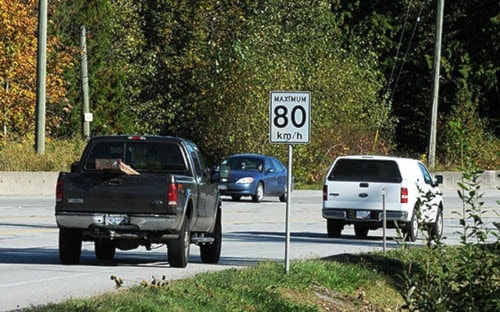These drivers don’t want to be lawbreakers – they think it’s criminal that the speed limit is 80 km/h on the Lougheed Highway between Maple Ridge and Mission.
Commuters who use that stretch would like to see it considered in Victoria’s review of speed limits.
For the first time in 10 years, the provincial government is embarking on an audit of the speed limits on highways between communities. Government is inviting public input and will be holding public forums in cities such as Kamloops – the Coquihalla Highway is most often mentioned as a route with the potential to have higher limits.
There is no forum planned for Maple Ridge, but if there was, it is likely government would hear a lobby to speed up the Lougheed.
Ridge Meadows RCMP noted earlier this year that the route from 240th Street to 287th (Mission border) is their primary area of enforcement. Since it has been made a four-lane highway in some areas, traffic is speeding up. However, the posted limits are still 80 km/h across the entire route.
A straw poll found most drivers would like to see the limit increased. And, those who think 80 km/h is a safe limit acknowledge that most traffic is exceeding it.
Doug Harding said he is on Lower Mainland highways regularly, driving from arena to arena for a hockey instruction service. He believes the Lougheed between Maple Ridge and Mission is safe and well engineered, and the public is already doing 90 km/h across most of the route.
“I wouldn’t raise it by more than about 10 km/h – and that’s what people are used to,” he said.
Mark Ulmer would go further.
“It wouldn’t hurt to go up to 100 km/h, everyone does that – at least,” he said.
“I think it’s adequate,” said John Randel of Abbotsford, but added most people want to go faster. “I put it on cruise control at 80, and everyone in passing me.”
Trevor Turncliff said he would keep the limit at 80 km/h.
“I don’t think it matters what they do. People are going to speed if they want to speed.”
But it matters to Ian Tootil, the former photo radar fighter who is now championing the cause of higher speed limits with the group Sense B.C. Its video “Speed Kills Your Pocketbook” has received almost 1.2 million views on YouTube in a month.
Because police in B.C. now have the authority to have vehicles impounded for excessive speeding, and new fines for excessive speeding can range from $368 to $483, it is important that speed limits be set at the uppermost limit that is safe, says Tootil.
“We want to legitimize the speeds that are already being done on our roadways,” he said.
He notes that since the U.S. federal government raised its maximum limit of 55 m/ph in 1996 – 37 of the 50 states have increased limits, and more are coming.
The fastest route in the U.S. is a Texas highway, with a speed limit of 138 km/h. This is an acknowledgement that vehicles handle better, with improvements such as traction stability and anti-lock brakes, have improved safety features, and roads are engineered to a higher standard.
He said that engineering is “wasted” if speed limits are artificially low. In addition, police resources are “misappropriated,” and some $60 million per year is spent on fines and points in B.C.
“This is money that’s coming out of the economy,” argues Tootil.
A common argument against raising speed limits is that: If people are doing 90 or 100 km/h when the limit is posted at 80 km/h, then they will push a little harder and do 100 or 110 km/h if the maximum speed is increased to 90 km/h.
Tootil said the experience of other countries shows that is not the case. The majority of drivers proceed at a speed that is safe based on road conditions, sightlines, their vehicle’s performance and a variety of other factors.
The top speed, he says, should be perceived by most drivers as a fast speed – uncomfortably to maintain for a long trip.
“It should be a limit. It should be the upper end of what people would normally travel,” he maintains, “instead of a baseline, where everyone knows there is no relationship between a posted sign and the speed people are actually driving.”
The province is in the process of a technical review of B.C. highways including the crash history, traffic volume and other features. It is also looking at research from around the world.
The public input portion of the review will take place in November.
Ridge Meadows RCMP declined to comment.
“It would be inappropriate for the RCMP to provide any comment or opinion during the ‘public input’ stage of this process. As noted in the Ministry of Transportation announcement, we will be engaged during the stakeholder process, and asked to provide input at that time,” said Sgt. Dale Somerville.
